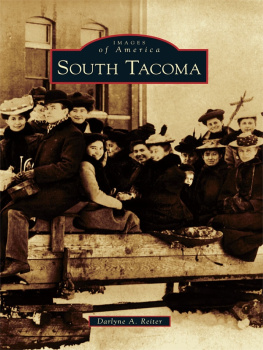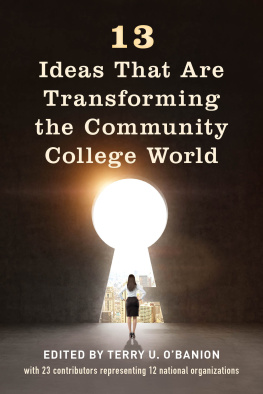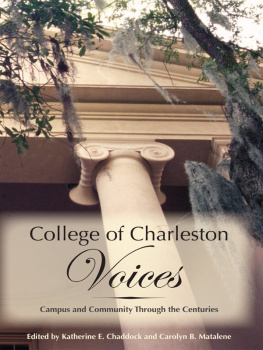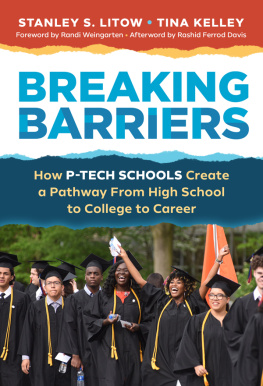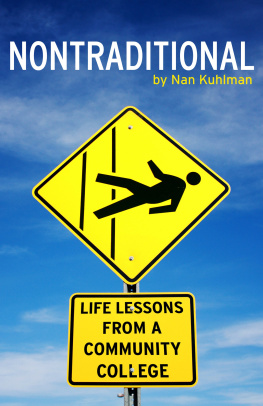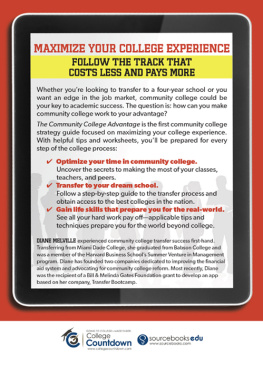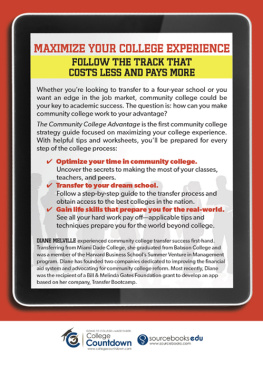The Open Door:
A History of Tacoma Community College
By Dale Coleman
Copyright 2015 Dale Coleman
All rights reserved.
This ebook is licensed for your personal enjoyment only. This ebook may not be re-sold or given away to other people. If you would like to share this ebook with another person, please purchase an additional copy for each person you share it with. If youre reading this book and did not purchase it, or it was not purchased for your use only, then you should purchase your own copy. Thank you for respecting the hard work of this author.
Ebook formatting by www.ebooklaunch.com
Contents
I would like to thank the members of the TCC History Advisory Board. This project would not have been possible without your guidance and support. To Allen Braden, Frank Garratt, Ron Magden, Georgia McDade, Dan Small, Richard Wakefield, Sharon Winters, Chris Young and Ed Zimmerman - thank you for all you continue to do in support of Tacoma Community College. I would also like to thank Shawn Jennison and Rachel Payne for their timely advice and feedback, Elizabeth Russell for allowing me to run riot, for over a year, in her beloved College Archive, and President Pamela Transue for her support of, and contribution to, this project. Finally, to the staff, faculty and students, who have participated in the Colleges oral history project or contributed to the growing college archive, thank-you for lending your invaluable stories and insights.
Congratulations, Tacoma Community College, on your 50 th anniversary. What a privilege it has been to serve as president here for almost eighteen of those fifty years.
From our very beginning, this college has been dedicated to serving all members of our community who seek fuller lives through education. We are distinguished from other types of higher education institutions by that community-driven mission. We have spent the last fifty years listening to our community and responding with offerings that combine opportunities for intellectual growth with career preparation.

A supportive community and our highly gifted faculty have made a first-rate education possible for all people, including those of limited means. We pride ourselves on an open door policy which ensures that people get a second chance on being successful as students. Our student services staff, and for that matter all staff throughout the College, provide a welcoming and supportive environment where students receive the resources they need to be successful and to reach their goals. We seek excellence through inclusionthrough helping people progress from wherever they arerather than by exclusion, accepting only those who have the highest likelihood of success.
There are those who mistakenly believe that an open door leads to lower standards, but that has never been the case at TCC. While some students must travel further than others to meet our standards, the standards themselves are never compromised. When our students go to work in health care settings, business offices, technology firms, legal firms, or human services agencies, they must be ready to meet and exceed the professional standards of their employers. When they transfer to universities to complete their bachelors degrees, they must be fully competitive with the students they encounter. And they are. Year after year, our students who transfer graduate at the same rate and the same GPA as the students who were admitted to these highly competitive universities as freshmen.
The celebration of our 50 th year provides a timely opportunity to reflect on the rich history of accomplishment that has brought us to where we are today. I hope you will enjoy this engaging story of the people and events who have shaped TCC.
Pamela Transue, PhD
President
A Community College in Tacoma
City of Destiny
Incorporated in 1875, Tacoma, Washington, earned the judicious nickname City of Destiny, as the terminus of the Northern Pacific Railroad. Planted along the banks of Commencement Bay, in the shadow of Mount Rainier (or Mount Tahoma, as it was known to the native Puyallup Tribe), Tacoma has a deeply ingrained history as a workers city -a city of factories and smelters built by labor, lumber and longshore. It is a military town, the home of two major military bases (merged, in 2010, as Joint Base Lewis-McChord, Tacomas largest employer) and the business hub of the South Puget Sound Region. Romanticized or derided, depending on your disposition, as Grit City by some, Tacoma is a place that owns its roots as a city of longshoremen and factory workers and embraces its present and future as a unique and growing metropolis in the midst of a cultural and economic renaissance.

Tacoma, WA, 1914 (A.H. Barnes)
Over the last 50 years, the influx of skilled labor and information work has had a transformative effect on the city. With large local employers like Boeing, Multicare, Franciscan Health and the proliferation of the technology industry to our north, demand has never been higher for local skilled workers. According to labor historian and original TCC faculty member Ron Magden, Tacoma was famous for being the factory city of workers -of dead end jobs- and the coming of the College signified that there was a chance for growth in other ways. In many ways, the growth of Tacoma Community College has paralleled the growth of the city, continuously transfiguring itself to reflect the needs and aspirations of its citizenry.
The Community College Movement
The impetus for the junior college was born amidst the Progressive Era social reforms of the early 20 th century. An increasing demand for higher education in the United States grew alongside a shifting view of the role of public education in American society. The Wisconsin Idea championed by U.S. Senator Robert M. La Follette Sr. and embraced by the University of Wisconsin in the early 1900s, extended the mandate of public higher education to the edification of all institutions and individuals within the states borders. Public higher education was intrinsically linked to the improvement of the political, social and economic conditions of the state. President Theodore Roosevelt praised forward-thinking Wisconsin as a laboratory for wise experimental legislation aiming to secure the social and political betterment of the people as a whole. It wouldnt take long for the Wisconsin Idea to spread throughout the nation.
Washingtons first junior college opened in 1915 on the top floor of Everett High School with 21 students. The College shuttered in 1923 due to a lack of enrollment. There were 15 students in the 1925 inaugural class at Centralia Junior College (now Centralia College), which is Washingtons oldest surviving 2-year institution. At its inception the junior college movement spread throughout the states population centers as small, self-supported college preparatory ventures, providing an academic bridge to Washingtons four year universities. It wasnt until the Great Depression produced a flood of unemployed and unemployable young workers looking for a leg up in an oppressively tight job market that the vocational and technical training, commonly associated with two-year institutions, began to gain a foothold.
In spite of being primarily housed within public high schools and run largely by school district faculty and administration, junior colleges would struggle to receive any type of state funding throughout the 1920s and 30s. It wasnt until 1941 that the passage of House Bill 102 provided official recognition and state financial support to junior colleges in Washington. In 1945 additional legislation allowed existing junior colleges to merge with their local school districts, increasing their funding and support exponentially. Perhaps most significantly, these newly recognized institutions gained the ability to acquire capital construction funding in order to build their own dedicated buildings. This set the stage for the rapid expansion of the junior college in Washington State. Unfortunately, it would take nearly two decades for Tacoma to be permitted to participate in this expansion.
Next page

